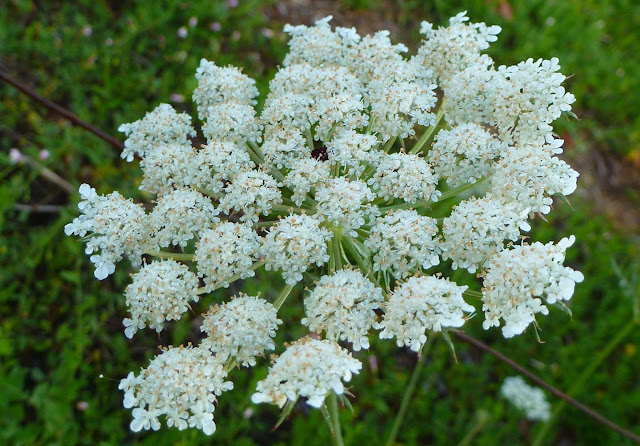There are a lot of Queen Anne's Lace plants out in the vineyard every year — this is our 16th summer here — but I truly believe that this year's bloom is the most amazing I've seen. So many vineyard rows look like this one.
The umbrella-shaped flower heads look like this. I'm sure you've seen them before, but you might not have seen so many of them at one time. The plant is actually a wild carrot.
Wikipedia says: "Daucus carota, whose common names include wild carrot, bird's nest, bishop's lace, and Queen Anne's lace (North America), is a white, flowering plant in the family Apiaceae, native to temperate regions of Europe and southwest Asia, and naturalized to North America and Australia."
The mature flowers are white, but when you look closely you see a lot of pink ones too. I think the pink cast is a feature of the flowers when they're young.
Only in North America is the wild carrot known as Queen Anne's Lace. It's not clear whether the queen it's named after was 18th century Anne, Queen of Great Britain, or her great grandmother, the 16th and 17th century Anne of Denmark.
If I understand correctly, the little spiny things you see in this last photo are the fruits of the wild carrot plant.






Does the plant actually grow a carrot-like root?
ReplyDeleteEvidently it does, but I've never dug one up to see the root. I read that it is edible in theory but tends to go woody pretty quickly. The flowers are edible too.
DeleteThey are quite a sight. Must have been all the rain which caused so many seeds to germinate. Thank goodness (as I think Walt mentioned) herbicides aren't being used to control them.
ReplyDeleteI wonder if not using herbicides is part of the requirements list for production of the new AOC Touraine Chenonceaux wines.
DeleteThey are lovely, especially when there are many growing together. They seem to be the precursor to the modern carrot per the net: http://www.carrotmuseum.co.uk/wild.html
ReplyDeleteThanks, D. Look at the page I linked to in my comment back to Roderick.
DeleteGiven what Autolycus has written below, Queen Anne's lace (aka cow parsley, which I do recall as another name for the plant) in England must be different, but I expect the settlers in the 13 colonies applied the name for the very similar plant they found there. Roderick
DeleteIn my youth (going back a long way) in England, it was always called Queen Anne's Lace. I don't know any other name. Roderick
ReplyDeleteThat's interesting. I wonder why Wikipedia says the QAL name is used only in North America? Look at this page about the wild carrot.
DeleteOften, Wikipedia has to be taken with a grain of salt!
DeleteI love these flowers and saw them on the roadsides in France as well as here in Illinois. When I was a child, we used to pick them and put them in a jar with a few drops of food coloring, each one getting to choose what color flowers we wanted. Now, I think they are just beautiful as they are.
ReplyDeleteI always understood, growing up in New England, that the Queen Anne name came from the English queen, although we called the 18th-century Queen Anne's War the French & Indian.
ReplyDeleteIn the UK, there is a very similar looking flower called Queen Anne's Lace, but its more prosaic name is cow parsley, and I gather it is different entirely from yours. A bit of googling suggests it's also possible to confuse it with hemlock, which is poisonous. Presumably the cows know how to distinguish them.....
ReplyDelete